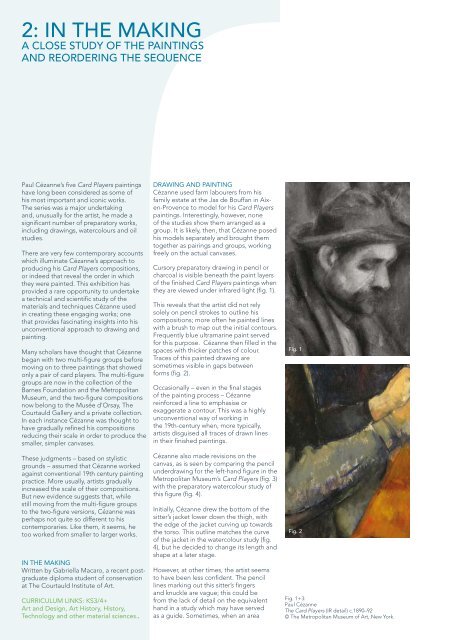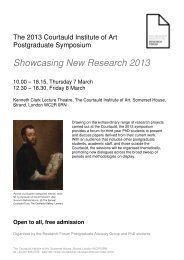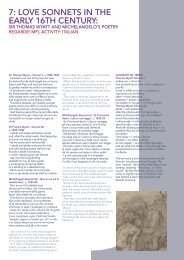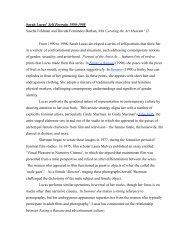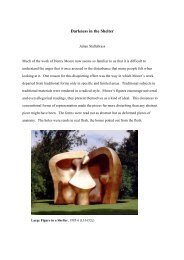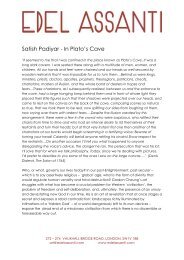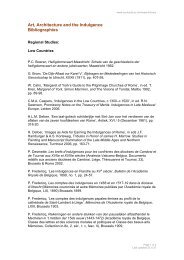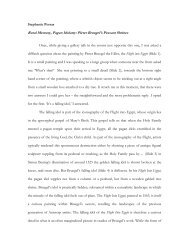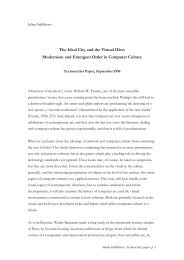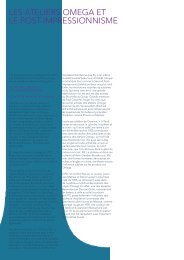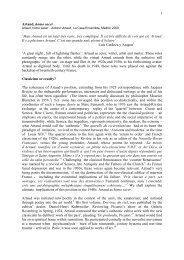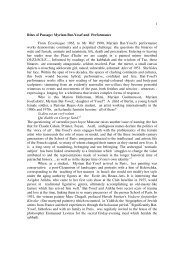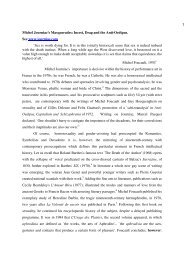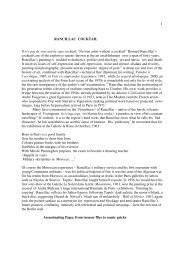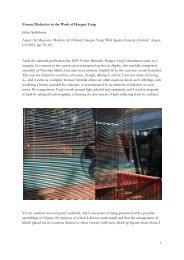TEACHERS' RESOURCE - The Courtauld Institute of Art
TEACHERS' RESOURCE - The Courtauld Institute of Art
TEACHERS' RESOURCE - The Courtauld Institute of Art
You also want an ePaper? Increase the reach of your titles
YUMPU automatically turns print PDFs into web optimized ePapers that Google loves.
2: IN THE MAKING<br />
A CLOSE STUDY OF THE PAINTINGS<br />
AND REORDERING THE SEQUENCE<br />
Paul Cézanne’s five Card Players paintings<br />
have long been considered as some <strong>of</strong><br />
his most important and iconic works.<br />
<strong>The</strong> series was a major undertaking<br />
and, unusually for the artist, he made a<br />
significant number <strong>of</strong> preparatory works,<br />
including drawings, watercolours and oil<br />
studies.<br />
<strong>The</strong>re are very few contemporary accounts<br />
which illuminate Cézanne’s approach to<br />
producing his Card Players compositions,<br />
or indeed that reveal the order in which<br />
they were painted. This exhibition has<br />
provided a rare opportunity to undertake<br />
a technical and scientific study <strong>of</strong> the<br />
materials and techniques Cézanne used<br />
in creating these engaging works; one<br />
that provides fascinating insights into his<br />
unconventional approach to drawing and<br />
painting.<br />
Many scholars have thought that Cézanne<br />
began with two multi-figure groups before<br />
moving on to three paintings that showed<br />
only a pair <strong>of</strong> card players. <strong>The</strong> multi-figure<br />
groups are now in the collection <strong>of</strong> the<br />
Barnes Foundation and the Metropolitan<br />
Museum, and the two-figure compositions<br />
now belong to the Musée d’Orsay, <strong>The</strong><br />
<strong>Courtauld</strong> Gallery and a private collection.<br />
In each instance Cézanne was thought to<br />
have gradually refined his compositions<br />
reducing their scale in order to produce the<br />
smaller, simpler canvases.<br />
<strong>The</strong>se judgments – based on stylistic<br />
grounds – assumed that Cézanne worked<br />
against conventional 19th century painting<br />
practice. More usually, artists gradually<br />
increased the scale <strong>of</strong> their compositions.<br />
But new evidence suggests that, while<br />
still moving from the multi-figure groups<br />
to the two-figure versions, Cézanne was<br />
perhaps not quite so different to his<br />
contemporaries. Like them, it seems, he<br />
too worked from smaller to larger works.<br />
IN THE MAKING<br />
Written by Gabriella Macaro, a recent postgraduate<br />
diploma student <strong>of</strong> conservation<br />
at <strong>The</strong> <strong>Courtauld</strong> <strong>Institute</strong> <strong>of</strong> <strong>Art</strong>.<br />
CURRICULUM LINKS: KS3/4+<br />
<strong>Art</strong> and Design, <strong>Art</strong> History, History,<br />
Technology and other material sciences..<br />
DRAWING AND PAINTING<br />
Cézanne used farm labourers from his<br />
family estate at the Jas de Bouffan in Aixen-Provence<br />
to model for his Card Players<br />
paintings. Interestingly, however, none<br />
<strong>of</strong> the studies show them arranged as a<br />
group. It is likely, then, that Cézanne posed<br />
his models separately and brought them<br />
together as pairings and groups, working<br />
freely on the actual canvases.<br />
Cursory preparatory drawing in pencil or<br />
charcoal is visible beneath the paint layers<br />
<strong>of</strong> the finished Card Players paintings when<br />
they are viewed under infrared light (fig. 1).<br />
This reveals that the artist did not rely<br />
solely on pencil strokes to outline his<br />
compositions; more <strong>of</strong>ten he painted lines<br />
with a brush to map out the initial contours.<br />
Frequently blue ultramarine paint served<br />
for this purpose. Cézanne then filled in the<br />
spaces with thicker patches <strong>of</strong> colour.<br />
Traces <strong>of</strong> this painted drawing are<br />
sometimes visible in gaps between<br />
forms (fig. 2).<br />
Occasionally – even in the final stages<br />
<strong>of</strong> the painting process – Cézanne<br />
reinforced a line to emphasise or<br />
exaggerate a contour. This was a highly<br />
unconventional way <strong>of</strong> working in<br />
the 19th-century when, more typically,<br />
artists disguised all traces <strong>of</strong> drawn lines<br />
in their finished paintings.<br />
Cézanne also made revisions on the<br />
canvas, as is seen by comparing the pencil<br />
underdrawing for the left-hand figure in the<br />
Metropolitan Museum’s Card Players (fig. 3)<br />
with the preparatory watercolour study <strong>of</strong><br />
this figure (fig. 4).<br />
Initially, Cézanne drew the bottom <strong>of</strong> the<br />
sitter’s jacket lower down the thigh, with<br />
the edge <strong>of</strong> the jacket curving up towards<br />
the torso. This outline matches the curve<br />
<strong>of</strong> the jacket in the watercolour study (fig.<br />
4), but he decided to change its length and<br />
shape at a later stage.<br />
However, at other times, the artist seems<br />
to have been less confident. <strong>The</strong> pencil<br />
lines marking out this sitter’s fingers<br />
and knuckle are vague; this could be<br />
from the lack <strong>of</strong> detail on the equivalent<br />
hand in a study which may have served<br />
as a guide. Sometimes, when an area<br />
Fig. 1<br />
Fig. 2<br />
Fig. 1+3:<br />
Paul Cézanne<br />
<strong>The</strong> Card Players (IR detail) c.1890–92<br />
© <strong>The</strong> Metropolitan Museum <strong>of</strong> <strong>Art</strong>, New York.


